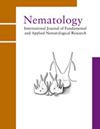Description of Ektaphelenchus phoenicis n. sp. (Rhabditida: Ektaphelenchinae), a morphological and molecular phylogenetic study
IF 1.2
4区 生物学
Q2 ZOOLOGY
引用次数: 0
Abstract
A new species of Ektaphelenchinae was recovered from the bark of a dead date palm (Phoenix dactylifera) tree, and from a soil sample collected from the rhizosphere of gramineous grasses in Iraq and Iran, respectively. It was assigned to the genus Ektaphelenchus mainly by the lack of a functional anus and rectum, and having a conical posterior body end (tail) in female, not ending to a filiform tip, and males lacking a bursa. The recovered populations were described based on morphological and molecular data. Ektaphelenchus phoenicis n. sp. is characterised by 346-441 μm long females, having three lines in lateral field, a 12.3-15.8 μm long stylet with wide lumen lacking basal knobs or swellings, high lip region separated from the rest of body by a depression, metacorpus elliptical with refractive valve plates almost in the middle to slightly posterior, excretory pore posterior to metacorpus, postvulval uterine sac (PUS) 9.3-14.8 μm long, usually containing sperm, posterior body end (tail) with ventrally bent distal end, males common in population with seven precloacal + cloacal + caudal papillae and slightly elevated cloacal lips under SEM, appearing as a differentiated flap-like structure under LM. The new species was morphologically compared with typologically similar species of Ektaphelenchus with a similar body size, namely: E. golestanicus, E. oleae and E. taiwanensis; a similar female posterior body end, namely: E. cupressi, E. kanzakii, E. prolobos and E. riograndensis; and E. goffarti having a similar postcloacal structure. The phylogenetic relationships of the new species with other relevant genera and species were reconstructed using near full length sequences of small and D2-D3 expansion segments of large subunit (SSU and LSU D2-D3) rDNA. In both inferred phylogenies, the newly generated sequences of Ektaphelenchus phoenicis n. sp. occupied a placement inside a maximally supported clade including sequences of three genera Ektaphelenchus, Ektaphelenchoides and Devibursaphelenchus.文章标题腓大鼠的形态与分子系统发育研究(横纹肌目:腓大鼠科)
从一棵死椰枣树的树皮和分别从伊拉克和伊朗的禾本科植物根际采集的土壤样本中发现了一个新的Ektaphelenchinae物种。它之所以被归入Ektaphelenchus属,主要是因为它缺乏功能性的肛门和直肠,雌性有一个圆锥形的身体后端(尾巴),没有末端到丝状尖端,雄性缺乏囊。根据形态学和分子数据对恢复的种群进行了描述。Ektaphelenchus phoenicis n.sp.的特征是346-41μm长的雌性,在侧视野中有三条线,12.3-15.8μm长管心针,管腔宽,没有基底结节或肿胀,高唇区通过凹陷与身体其他部分隔开,中心体椭圆形,折射阀板几乎在中心体的中间至稍后,中心体内有排泄孔,外阴后子宫囊(PUS)长9.3-14.8μm,通常含有精子,体后端(尾部)远端腹侧弯曲,SEM下男性常见,有7个阴道前+阴沟+尾乳头,阴沟唇略高,LM下呈分化的片状结构。将该新种与体型相似的Ektaphelenchus的形态相似种进行了比较,即:E.golestanicus、E.oleae和E.taiwanensis;一个类似的雌性后体末端,即:库佩西E.cupessi、坎崎E.kanzakii、Prorobos E.riograndensis;和具有相似的后循环结构的E.goffarti。利用大亚基(SSU和LSU D2-D3)rDNA的小片段和D2-D3扩增片段的近全长序列,重建了该新种与其他相关属和种的系统发育关系。在这两个推断的系统发育中,新生成的Ektaphelenchus phoenicis n.sp.序列位于一个最大支持的分支中,包括Ektapherenchus、Ektaphenenchoides和Devibursaphelenchus三个属的序列。
本文章由计算机程序翻译,如有差异,请以英文原文为准。
求助全文
约1分钟内获得全文
求助全文
来源期刊

Nematology
生物-动物学
CiteScore
2.60
自引率
33.30%
发文量
67
审稿时长
3 months
期刊介绍:
Nematology is an international journal for the publication of all aspects of nematological research (with the exception of vertebrate parasitology), from molecular biology to field studies. Papers on nematode parasites of arthropods, and on soil free-living nematodes, and on interactions of these and other organisms, are particularly welcome. Research on fresh water and marine nematodes is also considered when the observations are of more general interest.
Nematology publishes full research papers, short communications, Forum articles (which permit an author to express a view on current or fundamental subjects), perspectives on nematology, and reviews of books and other media.
 求助内容:
求助内容: 应助结果提醒方式:
应助结果提醒方式:


